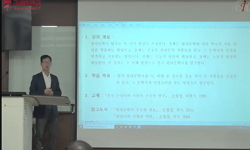This paper is to find out the characteristics and position of the national movement of Baek Cho-wol (1878∼1944) who was recently recognized as one of the fighters for independence. To do this, I tried to analyze by comparing him with Baek Yong-seong...
http://chineseinput.net/에서 pinyin(병음)방식으로 중국어를 변환할 수 있습니다.
변환된 중국어를 복사하여 사용하시면 됩니다.
- 中文 을 입력하시려면 zhongwen을 입력하시고 space를누르시면됩니다.
- 北京 을 입력하시려면 beijing을 입력하시고 space를 누르시면 됩니다.
백초월 독립운동의 성격 - 용성·만해와 비교하여 본 단면 - = Characteristics of Baek Cho-wol’s Independence Movement - Comparing to that of Yongseong and Manhae -
한글로보기https://www.riss.kr/link?id=A105225061
- 저자
- 발행기관
- 학술지명
- 권호사항
-
발행연도
2017
-
작성언어
-
-
주제어
백초월 ; 백용성 ; 한용운 ; 불교 독립운동 ; 진관사 ; 영원사 ; 대각사 ; 일심교 ; Baek Cho-wol ; Baek Yong-seong ; Han Yong-un ; Buddhist independence movement ; Jingwansa Temple ; Yeongwonsa Temple ; Daegaksa Temple ; Ilsimgyo
-
KDC
200
-
자료형태
학술저널
-
수록면
77-102(26쪽)
- 제공처
- 소장기관
-
0
상세조회 -
0
다운로드
부가정보
다국어 초록 (Multilingual Abstract)
Based on this background, I have compared Chowol with Yongseong and Manhae. I have analyzed him in four areas including his asceticism, his whereabouts before participating in March First Independence Movement, contents of independence movement, the memories and research on his spirit and accomplishments.
However, the research on Baek Cho-wol should be supplemented more. Therefore, as the viewpoint of the research on Baek Cho-wol, I propose the identity called Gangbaek, Gangwon, the fact that he directed the domestic Buddhists’ independence movement, his relationships with the provisional government and the national independence army in Manchuria, and a detailed approach to Ilsimgyo.
With regard to the representative 3 figures (Yongseong, Manhae and Chowol) of Buddhist fighters for independence that I have emphasized, I would propose a reconsideration for the recognition of them. I will compensate the weakness of this paper through consistent research, however, I am still waiting for the researchers’ criticism.
This paper is to find out the characteristics and position of the national movement of Baek Cho-wol (1878∼1944) who was recently recognized as one of the fighters for independence. To do this, I tried to analyze by comparing him with Baek Yong-seong and Manhae Han Yong-un who were the Buddhist fighter for independence of the modern times. This idea came from my belief that we have to understand Baek Cho-wol, Baek Yong-seong and Han Yong-un equally.
Based on this background, I have compared Chowol with Yongseong and Manhae. I have analyzed him in four areas including his asceticism, his whereabouts before participating in March First Independence Movement, contents of independence movement, the memories and research on his spirit and accomplishments.
However, the research on Baek Cho-wol should be supplemented more. Therefore, as the viewpoint of the research on Baek Cho-wol, I propose the identity called Gangbaek, Gangwon, the fact that he directed the domestic Buddhists’ independence movement, his relationships with the provisional government and the national independence army in Manchuria, and a detailed approach to Ilsimgyo.
With regard to the representative 3 figures (Yongseong, Manhae and Chowol) of Buddhist fighters for independence that I have emphasized, I would propose a reconsideration for the recognition of them. I will compensate the weakness of this paper through consistent research, however, I am still waiting for the researchers’ criticism.
동일학술지(권/호) 다른 논문
-
율풍진작(律風振作)을 통(通)한 한국불교 중흥(中興)의 행적(行蹟)
- 동국대학교 전자불전문화콘텐츠연구소
- 법혜(최창식) ( Ven. Beop Hye(choi
- 2017
-
- 동국대학교 전자불전문화콘텐츠연구소
- 이재수 ( Lee Jes Soo )
- 2017
-
백용성 대종사 총서 아카이브 시스템 구축과 총서 사업의 완료
- 동국대학교 전자불전문화콘텐츠연구소
- 동국대학교전자불전문화콘텐츠연구소
- 2017
-
- 동국대학교 전자불전문화콘텐츠연구소
- 이수창 ( Lee Soo-chang )
- 2017




 KISS
KISS



